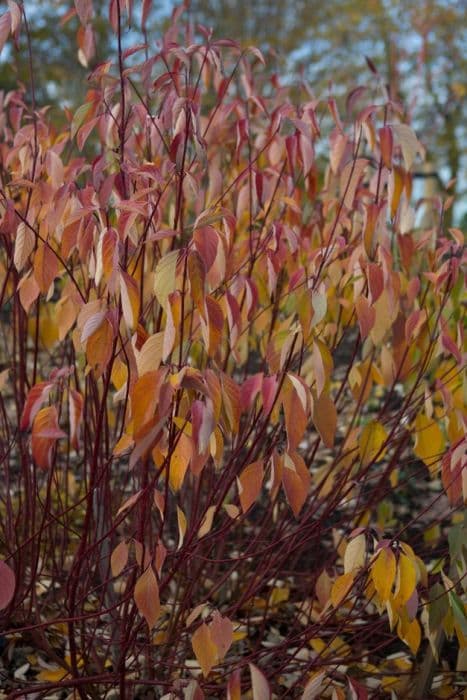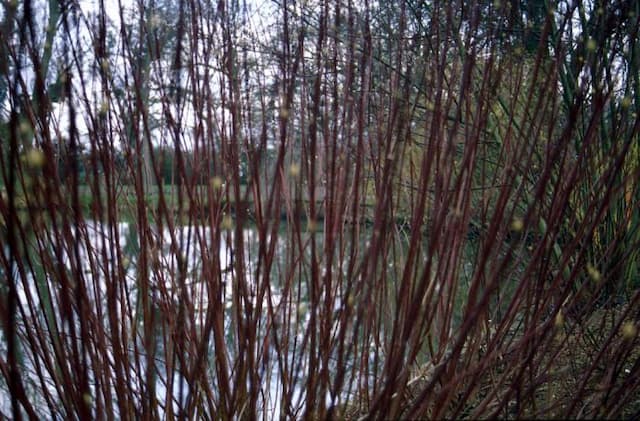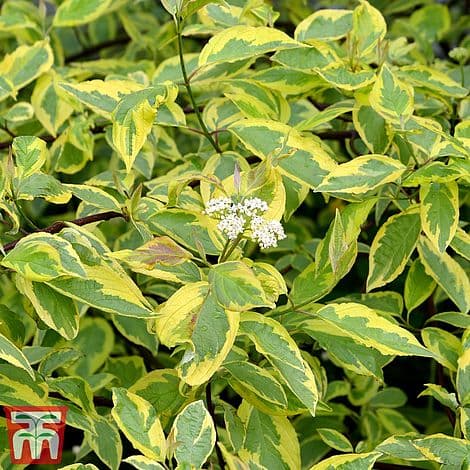Giant dogwood Cornus controversa











ABOUT
Cornus controversa, commonly known as the giant dogwood, is a visually striking plant known for its unique growth pattern and aesthetic appeal in gardens and parks. The notable characteristic of this plant is its horizontal, tiered branches that give it a layered look, resembling a pagoda, which is why it's sometimes referred to as the 'wedding cake tree'. During spring, the giant dogwood produces a showy display of small, creamy-white flowers that form flat-topped clusters, adding to its ornamental value. As the seasons change, these flowers give way to dark, berry-like fruits that are attractive to birds and other wildlife. The foliage of the giant dogwood is also eye-catching, with broad, ovate leaves that boast a smooth margin. These leaves turn to vibrant shades of red and purple, making a spectacular show in the autumn landscape. The bark of the giant dogwood is gray to brown, providing a textured look and additional interest, especially during the bare winter months when the leaves have fallen. Overall, this species of the dogwood family is prized for its distinctive architecture, seasonal colors, and the interest it adds to any setting where size constraints are not a primary concern.
About this plant
 Names
NamesFamily
Cornaceae.
Synonyms
Giant Dogwood, Wedding Cake Tree, Table Dogwood.
Common names
Swida controversa, Cornus brachypoda, Aronia controversa, Thelycrania controversa.
 Toxicity
ToxicityTo humans
The plant known as the Giant Dogwood is not generally considered toxic to humans. However, the consumption of any plant material may cause adverse reactions in some individuals due to allergies or sensitivities, and it is always best to avoid ingesting plants that are not known to be safe for consumption. There are no well-documented cases of poisoning from consuming the Giant Dogwood, and it does not contain any known toxic principles that would cause harm to humans.
To pets
The plant known as the Giant Dogwood is not generally considered toxic to pets. It is not listed as a commonly toxic plant to dogs or cats by the ASPCA and other animal poison control organizations. Pets may sometimes experience mild stomach upset if they consume a large amount of plant material due to the non-digestible fibers, but the Giant Dogwood does not contain any known toxic constituents that would cause serious harm or poisoning in pets.
 Characteristics
CharacteristicsLife cycle
Perennials
Foliage type
Deciduous
Color of leaves
Green
Flower color
White
Height
20-30 feet (6-9 meters)
Spread
15-25 feet (4.5-7.5 meters)
Plant type
Tree
Hardiness zones
5-7
Native area
East Asia
Benefits
 General Benefits
General Benefits- Ornamental Appeal: Cornus controversa, commonly known as the Giant Dogwood, features attractive tiered branches and a distinctive horizontal growth pattern that enhances garden aesthetics.
- Seasonal Interest: It showcases white flowers in spring and vibrant reddish-purple foliage in autumn, providing year-round visual interest.
- Shade Provision: The broad, spreading canopy offers ample shade, making it a suitable choice for parks and large gardens.
- Wildlife Habitat: The tree produces berries that attract birds and other wildlife, supporting biodiversity.
- Erosion Control: The root system can help to stabilize slopes and prevent soil erosion.
- Urban Tolerance: Giant Dogwood is relatively tolerant of urban pollution and can be planted in city environments.
 Medical Properties
Medical Properties- Anti-inflammatory: Cornus controversa may have properties that help reduce inflammation.
- Antipyretic: It is believed to help reduce fever.
- Antioxidant: The plant may contain compounds that act as antioxidants, offering protection against oxidative stress.
- Cardiovascular Health: Compounds found in Cornus controversa could be beneficial for heart health, potentially improving circulation and reducing the risk of heart diseases.
- Antiviral: Traditional use suggests it might have antiviral effects, but scientific evidence is needed to support this.
- Immune Support: There may be components within the plant that support the immune system.
 Air-purifying Qualities
Air-purifying QualitiesThis plant is not specifically known for air purifying qualities.
 Other Uses
Other Uses- Cornus controversa, also known as the Giant dogwood, can be used as a natural dye source. The bark and leaves contain tannins and can be used to create dyes for fabrics.
- Giant dogwood berries, though not popular for human consumption, are edible when ripe and can make a survival food in times of need.
- The wood of the Giant dogwood is quite hard and has been used historically to make small turned objects such as tool handles and intricate woodworking projects.
- Giant dogwood's horizontal branches are sometimes used by gardeners and landscapers to create natural arbors or trellises for climbing plants.
- When pruned properly, the Giant dogwood can serve as a natural privacy screen due to its dense foliage and broad growth habit.
- In winter, the leafless silhouette of the Giant dogwood, with its characteristic tiered branches, is valued for adding architectural interest to a dormant garden.
- Bird enthusiasts often plant Giant dogwood in their gardens to attract birds, as its fruit is a desirable food source for various bird species.
- The Giant dogwood's extensive root system can be used in erosion control to help stabilize slopes and riverbanks.
- Due to its distinctive appearance, Giant dogwood tree is used as a subject in photography and painting, providing an aesthetic backdrop for artists and photographers.
- The tree is a popular choice in urban environments for its tolerance to pollution and ability to thrive in confined soil spaces.
Interesting Facts
 Feng Shui
Feng ShuiThe Giant Dogwood is not used in Feng Shui practice.
 Zodiac Sign Compitability
Zodiac Sign CompitabilityThe Giant Dogwood is not used in astrology practice.
 Plant Symbolism
Plant Symbolism- Beauty: With its elegant horizontal branches and flat-topped crown, Cornus controversa, commonly known as the Giant Dogwood or Wedding Cake Tree, represents beauty in nature, often admired in ornamental gardens.
- Balance: The symmetrical, tiered arrangement of its branches symbolizes balance and harmony, making it a favored plant for bringing these elements into a garden setting.
- Growth and Renewal: As a deciduous tree that sheds its leaves and grows new ones annually, the Giant Dogwood represents the natural cycle of growth and renewal.
- Unity: Because of its common name, 'Wedding Cake Tree,' it can represent unity and the layered complexity of relationships, much like the layers of a wedding cake.
- Eternity: The long-lasting nature of the tree, which can live for many years, is often connected with eternity and enduring principles.
 Water
WaterThe Giant Dogwood (Cornus controversa) should be watered deeply to ensure the soil is moist but not waterlogged. Young trees require more frequent watering, about once a week, with 1-2 gallons of water, especially during dry spells. Mature trees have more drought tolerance but will still benefit from the same amount of water every two weeks if there is no significant rainfall. Always check the soil moisture before watering; it should be damp at a depth of a couple of inches. Over-watering can lead to root rot, so it's crucial to allow the soil to dry out slightly between watering sessions.
 Light
LightThe Giant Dogwood thrives best in partial shade to full sun. A spot where the plant receives morning sunlight and afternoon shade is ideal, protecting it from the intense heat of the midday sun. However, it is adaptable and can also handle full sunlight, provided it receives adequate moisture. Ensure the plant has exposure to at least four hours of direct sunlight daily to promote healthy growth and flowering.
 Temperature
TemperatureThe Giant Dogwood prefers a temperate climate and thrives in a temperature range between 60°F and 75°F. It can withstand minimum temperatures down to around -20°F, making it hardy and adaptable to various environments. To maintain optimal growth, avoid exposure to extreme heat above 85°F for extended periods.
 Pruning
PruningPruning the Giant Dogwood is essential to maintain its health and structure. Prune in late winter or early spring before the new growth starts. Remove any dead, diseased, or broken branches, and thin out the canopy if necessary to allow light and air circulation. Prune sparingly as the Giant Dogwood has a naturally attractive shape; excessive pruning can harm the tree's form. It is typically not necessary to prune every year, but regular inspections will determine when pruning is needed.
 Cleaning
CleaningAs needed
 Soil
SoilThe Giant Dogwood prefers a well-draining, fertile soil with a pH of 5.5 to 6.5. A mix of loam, compost, and peat moss can provide the required nutrient-rich, slightly acidic conditions. Perlite or sand can be added to improve drainage.
 Repotting
RepottingGiant Dogwoods planted in containers may need repotting every 2-3 years to prevent root-bound conditions. Check yearly in the spring and repot if roots circle the pot's bottom.
 Humidity & Misting
Humidity & MistingGiant Dogwood thrives in moderate humidity levels. It does well in an outdoor setting where the natural humidity typically provides for its needs, without the requirement for additional humidity.
 Suitable locations
Suitable locationsIndoor
Ensure bright, indirect light and maintain slight humidity.
Outdoor
Plant in partial shade with mulch and shield from strong winds.
Hardiness zone
5-9 USDA
 Life cycle
Life cycleCornus controversa, commonly known as the Giant Dogwood, begins its life cycle when seed dispersal occurs, typically by birds who eat the fruit and excrete the seeds. Germination follows, during which the seed absorbs water, begins to swell, and eventually a root emerges to anchor into the soil and absorb nutrients, while a shoot pushes upwards towards light. The sapling stage comes next, where the young plant develops a woody stem and a branching structure, and it grows leaves that are necessary for photosynthesis. As it matures into an adult tree, it develops a characteristic horizontal tiered habit, blossoms in late spring with clusters of small white flowers that are attractive to pollinators, and in the fall, produces spherical blue-black fruit. Each year the tree goes through a seasonal cycle of growing new leaves in the spring, flowering, and then dropping its leaves in the autumn. The Giant Dogwood can live for many years, continuously growing, reproducing, and eventually completing its life cycle when it dies, decomposes, and returns nutrients to the soil.
 Propogation
PropogationPropogation time
Spring-Early Summer
Cornus controversa, commonly known as the giant dogwood, is most successfully propagated through seed germination or softwood cuttings. For seeds, the best time for sowing is in autumn shortly after seed maturation, but they require cold stratification for 120 days at 39 degrees Fahrenheit (4 degrees Celsius) for optimal germination. Softwood cuttings are usually taken in late spring to early summer when new growth is about 4-6 inches (10-15 centimeters) long and still flexible. The cuttings should be treated with a rooting hormone before being placed in a well-draining medium, such as a mix of peat and perlite, and then kept under consistent humidity and indirect but bright light until they root, which will likely take several weeks. This method allows for a faster production of young plants that are genetically identical to the parent.









